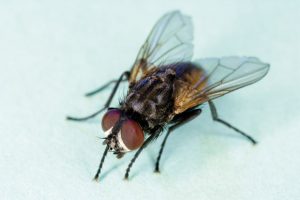Delivering a virus to control houseflies
Houseflies can transmit hundreds of animal and human pathogens like Salmonella, Escherichia coli and Shigella bacteria, which cause food borne illnesses. Insecticides are used to help control flies, but the pests can develop resistance to chemicals.
Entomologists with the ARS Center for Medical, Agricultural and Veterinary Entomology in Gainesville, Fla., examined salivary gland hypertrophy virus (SGHV), a member of a newly discovered family of viruses called Hytrosaviridae.
Collaborating with scientists at the University of Florida and Denmark’s Aarhus University, the investigation looked at SGHV’s distribution and host range, and the effectiveness of different application methods on house flies. The virus reproduces in the salivary gland of the infected insects, preventing the females from laying eggs and preventing the males from mating.

Comparison of a healthy fly (A) and a fly infected with SGHV (B). The fly with SGHV shows underdeveloped ovaries (ov) and overdeveloped salivary glands (sg).
Scientists examined different approaches to increase the virus infection rate in flies. The best method was a crude mixture of Danish SGHV-infected flies and water. A strain of healthy flies that had been dipped directly into the mixture or that walked on treated surfaces had an infection rate of 56 percent. A Florida strain had a 50 percent infection rate.
Liquid baits containing SGHV produced an infection rate of 22 percent (Danish virus) or 26 percent (Florida virus) in flies. When flies were sprayed directly with SGHV, the Danish virus infected 18 percent and the Florida virus infected 22 percent. In other laboratory tests, Florida houseflies were highly susceptible when injected with SGHV. Black dump flies were severely affected, and stable flies died quickly or failed to develop ovaries after injection.
While the virus shows great potential in controlling house and other filth flies, it is not a quick fix. However, SGHV could become part of an integrated management program that involves treating natural fly populations early during peak season to reduce reproduction……
This is a preview of a full article published in International Pest Control – May/June 2013 issue.
View full article online
The full text of this article is available to subscribers of International Pest Control.
Subscribe for online access
Subscribe to International Pest Control for full online access to all articles in every issue since 2004.
Author: Christopher Geden.
ARS Mosquito and Fly Research Unit, Gainesville, Florida, USA. ARS is the chief intramural scientific research agency of the U.S. Department of Agriculture.
Category: Public health











